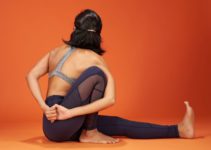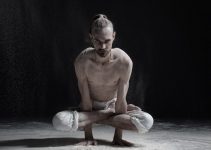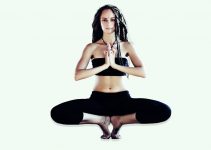- Meaning
- Precautions & Contraindications
- How to Do
- Modifications
- Variations
- Chaturanga Dandasana Benefits

Chaturanga dandasana forms a major component of the Ashtanga, vinyasa, and power yoga. It is also known by its other names, viz. Four-Limbed Staff Pose, low plank, and Chaturanga yogasana.
It is a beginner level balancing pose performed in the prone position. To maintain this pose the body is kept straight and balanced parallel to the floor.
Four-limbed staff pose is also a part of the popular yoga sequence Sun Salutation. The strength and balance required in the pose work as a foundation to other poses in the Sun salutation series.
Meaning and Interpretation
Chaturanga dandasana has four root terms of Sanskrit. ‘Chatur’ means ‘four’ , ‘anga’ means ‘limbs’, ‘danda’, is ‘staff or support’, and ‘asana’ refers to ‘pose.’
The name of the asana shows its significance. In Chaturanga dandasana, the body is balanced on the four limbs, i.e. two palms and toes of both the feet. Holding the pose requires bending the elbows at 90° along the body. The term ‘danda’ or ‘staff’ refers to the spine as the central support system which comes in complete straight shape in this pose. Other than Dandasana, chaturanga pose in yoga specifically focus on the alignment of the spine.
By challenging the body balance, the posture strengthens the muscles of arms, wrists, and abdomen. The pose also improves the posture of the body as it involves and strengthens the spine, the central supporting system of the body.
Chaturanga Dandasana Practice Guide
For safe and easy practice of Chaturanga Dandasana, follow the points below;
Precautions
- Maintain the posture with the correct alignment of the body.
- Keep a sharp 90 degrees angle between your upper arms and forearms.
- Discontinue the pose if there is a discomfort in the shoulder or spine.
Contraindications
- In case of an injury in the back, shoulder, or hand it is not recommended to perform these poses.
- Do not practice this asana during the later months of pregnancy.
- People with carpal tunnel syndrome must avoid practicing chaturanga dandasana.
Preparatory pose
- Plank Pose (Phalakasana)
- Cobra Pose (Bhujangasana)
- Upward-Facing Dog Pose (Urdhva Mukha Svanasana)
How to Do Chaturanga Dandasana (Steps)
- Begin with sitting in Vajrasana.
- Start walking your hands forward stretching the legs and attain plank position.
- Ensure to keep the hands under the shoulders.
- Turn your toes in, balance your body on toes, and hands. Keep looking forward.
- Exhale and bend your elbows pressing your palms to the floor.
- Bring your shoulders to the level of the bent elbows.
- Hold the pose for 10-20 seconds and keep breathing.
- Exhale and bring the body back to the full plank pose. Take a breath in.
- Now, exhale bending your knees and walking the hands towards you.
- Sit back in Vajrasana, and relax.
Beginner’s tips
- Perform it with lowering the knees to the floor. Later, bring your upper body closer to the floor keeping a gap of an inch or two.
- Keep your core engaged and do not lose your abdomen to the floor.
- Keep the body parallel to the floor, avoid the tendency to raise your hips while maintaining the pose.
Follow-up Poses
- Downward-Facing Dog (Adho Mukha Svanasana)
- Upward-Facing Dog Pose (Urdhva Mukha Svanasana)
Modifications and Props
- Yoga blocks – Perform chaturanga dandasana taking support from the blocks. You can keep two blocks under your shoulders to maintain their level. You can also place a block under your sternum or abdomen to keep the body parallel to the floor.
- Bolster – Bolster can also be used to support the upper body. Place it under you vertically from your chest to the abdomen.
- Yoga Strap – Use a strap by making a loop out of it with a width equal to shoulders. Draw your arms between the loop and bring the loop up to your elbows. The strap ensures that your hands stay under shoulders.
Variations

- Chaturanga Dandasana Variation – Start with the plank position and before you come down drop your knees to the floor. Now, lift your heels towards the ceiling. Bring your shoulders to the elbows’ level keeping the upper arms perpendicular to the forearms. Maintain the pose.
- Double chaturanga- It starts with a high plank and then pressing palms to the floor brings your shoulders to the elbows level. Then, come up to the high plank and again press the palms to bring the shoulders down to the elbows level.
- Three-legged chaturanga- After attaining the high plank, raise your one leg lifting the toes off the floor. Now bend both the elbows to the 90°. This makes one of the variations of chaturanga dandasana.
- Knee-to-arm chaturanga- Come to the plank pose and lift the right toes off the floor bending the knee slightly. Now bring the bent knee to the upper right arm. Then bend your elbows to 90° and lower your shoulders to the elbows.
- Chaturanga dandasana feet against a wall– In this variation, the posse is held by standing in front of a wall. Bend the elbows at 90° in pointing the fingers upwards in front of the ribs. Bring your hands forward on the wall and start leaning forward similar to a triceps pushup against the wall.
Chaturanga Dandasana Benefits
1. Strengthens the muscles
The regular practice of chaturanga dandasana provides strength to the muscles. It involves balancing the body on arms. This activates and strengthens the muscles of shoulders, arms, chest, neck, and upper back [efn_note] Use of Yoga Elements in the Training of Martial Arts http://www.jett.dormaj.com/docs/Volume8/Issue%202/Use%20of%20Yoga%20Elements%20in%20the%20Training%20of%20Martial%20Arts.pdf [/efn_note].
These muscles experience contraction while holding the pose and gradually become strong and toned. Plus, it improves the blood circulation on the upper body.
2. Improves posture
The asana involves balancing the body keeping it parallel to the floor. During the pose, the back is kept erect. Thus with regularly practicing the pose, the shape of the spine and upper back improves which corrects the posture of the body [efn_note] Yoga Improves Upper-Extremity Function and Scapular Posturing in Persons with Hyperkyphosis https://www.ncbi.nlm.nih.gov/pmc/articles/PMC3965199/ [/efn_note].
3. Builds endurance
Along with the arms and toes, the body is also balanced by the abdominal muscles in chaturanga dandasana. This involves the muscles of the core to keep the body parallel to the floor. It strengthens the core and boosts endurance [efn_note] Core muscle function during specific yoga poses
Author links open overlay panel https://www.sciencedirect.com/science/article/abs/pii/S0965229914000107 [/efn_note].
4. Enhances flexibility
There is a crucial step that brings the body to this pose, i.e. bending of the elbows. It shifts the weight to the forearms. This eventually makes the elbows and wrist flexible along with increasing their strength.
5. Improves digestion
Along with contracting the abdominal muscles when the core is involved in the pose, it stimulates digestive organs. This ameliorates the functioning of the digestive system and digestion improves.
6. Enhances respiration
This pose involves working out the chest muscles. It tones and expands the chest cavity and strengthens the intercostal muscles [efn_note] A Role Of ‘Surya Namaskara’ For Good Health https://www.aiirjournal.com/uploads/Articles/2020/03/4434_25.Vd.Manisha%20Nikam.pdf [/efn_note]. This facilitates the respiratory system and improves respiration.
7. Elongates the spine
The pose involves pulling the upper body forward. This lengthens and expands the spinal muscles. It also stretches the muscles around the neck. Therefore, it helps in lengthening the spine.
Conclusion
Try out chaturanga dandasana along with its variations to explore its health benefits.
Use this foundational yoga pose to have toned muscles and body and to improve and prepare your body for challenges.




